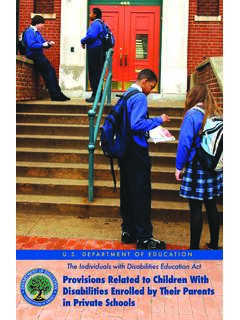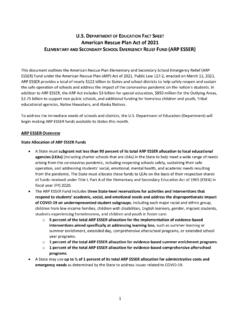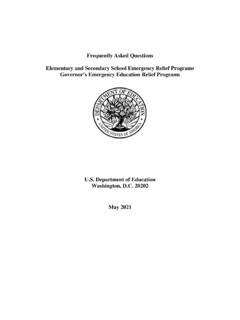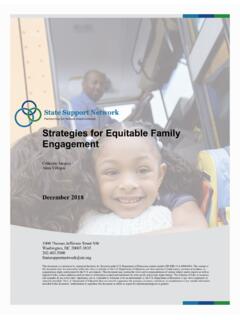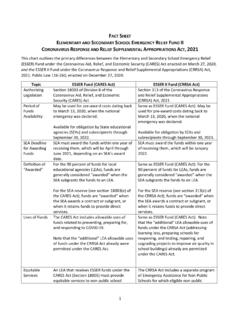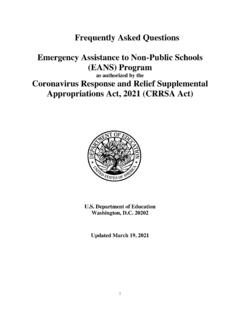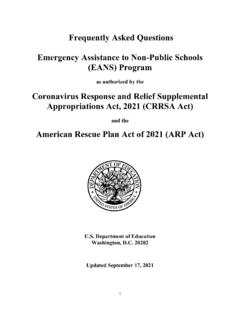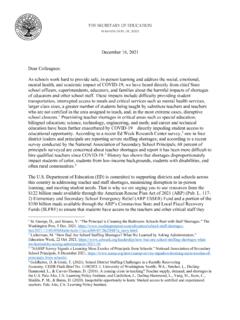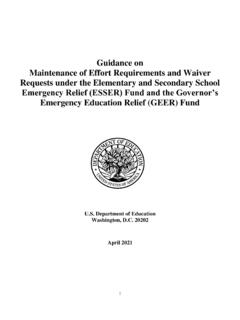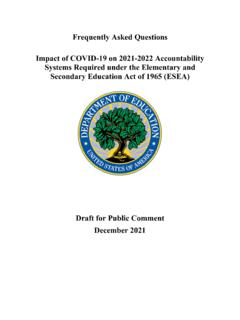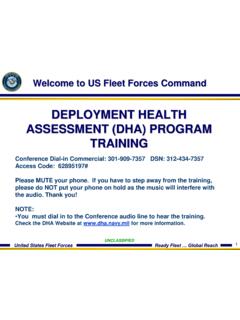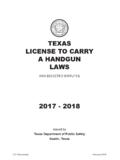Transcription of Elementary and Secondary School Emergency Relief Fund
1 1 Elementary and Secondary School Emergency Relief Fund Frequently Asked Questions about the Elementary and Secondary School Emergency Relief Fund (ESSER Fund) PURPOSE OF THIS DOCUMENT The purpose of this document is to answer Frequently Asked Questions related to the Elementary and Secondary School Emergency Relief Fund (ESSER Fund). Under the ESSER Fund, established as part of the Education Stabilization Fund in the CARES Act,1 State educational agencies (SEAs) will award subgrants to local educational agencies (LEAs) to address the impact that the Novel Coronavirus Disease 2019 (COVID-19) has had, and continues to have, on Elementary and Secondary schools across the Nation. This Frequently Asked Questions document seeks to answer questions that are not easily understood from a plain reading of Section 18003 and other parts of the CARES Act or the ESSER Fund Certification and Agreement (C&A).
2 It was developed in direct response to questions that the Department has received from SEA and LEA grant administrators implementing the ESSER Fund program. The Department of Education (Department) may provide additional or updated information, as necessary, on the Department s website at: If you have questions that are not answered in this document, please e-mail 1 The Coronavirus Aid, Relief , and Economic Security Act (CARES Act), Public Law 116-136, 134 Stat. 281 (Mar. 27, 2020). All citations in this document are to the CARES Act, unless otherwise indicated. The provisions of the CARES Act relevant to the ESSER Fund and other Department of Education programs are available on the Department s website at Disclaimer Other than statutory and regulatory requirements included in the document, such as those pursuant to the authorizing statute and other applicable laws and regulations, the contents of this document do not have the force and effect of law and are not meant to bind the public in any way.
3 This document is intended only to provide clarity to the public regarding existing requirements under the law or agency policies. In addition, it does not create or confer any rights for or on any person. 2 1. Who applies to the Department for ESSER formula funds? Only SEAs in the 50 States, Puerto Rico, and the District of Columbia apply directly to the Department for ESSER Funds. An SEA is the agency primarily responsible for the State supervision of public Elementary schools and Secondary For example, an SEA may be called the [State name] Department of Education or the [State name] Office of Public Instruction. The Bureau of Indian Education and the Outlying Areas are not eligible to receive ESSER formula funds. Congress provided a separate set aside in the Education Stabilization Fund to provide funds to those entities. 2. How do School districts or other entities access ESSER formula funds?
4 School districts (LEAs) must apply to the relevant SEA. Every SEA must use at least 90 percent of its ESSER Fund grant to make subgrants to LEAs by formula based on FY 2019 Title I, Part A allocations. (For more information on allocating funds to LEAs, see the Technical Appendix.) 3. What happens to the other 10 percent of ESSER funds? An SEA may retain 10 percent or less of its ESSER Fund grant (the SEA Reserve ), to address Emergency needs as determined by the SEA resulting from COVID-19, which may be addressed through the use of subgrants or contracts. As described below, from the SEA Reserve, the SEA may also use one-half of one percent of its total grant for administrative costs. 4. Who is eligible to receive ESSER funds from the SEA Reserve? A wide range of entities, including LEAs and organizations serving students and families, may be a subrecipient of funds from the SEA Reserve.
5 A subrecipient includes any entity that receives a subgrant or contract consistent with applicable State and Federal subgrant and procurement standards. Entities interested in learning more about an SEA s intended use of its reserve should contact the SEA. 5. May an SEA reserve ESSER funds for administrative costs? Yes. An SEA may reserve of 1 percent or less of its total ESSER allocation for administrative costs, including both direct and indirect administrative costs. This reservation must come from the SEA Reserve and is not subject to the requirement that funds be awarded within one year. Funds for administrative costs remain available to the SEA for obligation through September 30, 2022. 6. Are ESSER funds a supplement to an LEA s ESEA Title I, Part A grant award? No. The ESSER Fund is a separate Federal program. ESSER funds must be awarded and tracked separately from Title I, Part A funds.
6 2 The definition of SEA is from ESEA section 8101(49). 3 7. What is the overall timeline for using ESSER funds? 8. Is there a deadline by which an SEA must award ESSER funds to subrecipients? Yes. SEAs must award ESSER formula subgrants to LEAs within one year of receiving the State allocation. An SEA must also make awards with its SEA Reserve within one year of receiving the State allocation. Any funds that the SEA fails to award by the one-year deadline must be returned to the Department for reallocation consistent with the CARES Act. 9. How long are ESSER funds available for obligation by subrecipients? ESSER funds are available for obligation by LEAs and other subrecipients through September 30, 2022, which includes the Tydings period (General Education Provisions Act 421(b)(1)). 10. What is the difference between awarding and obligating funds?
7 An SEA awards funds when it makes a subgrant to an LEA or, in the case of the SEA Reserve, when it enters into a subgrant or contract with a subrecipient. ESSER funds are obligated when the subrecipient commits those funds to specific purposes consistent with 34 If an SEA awards a contract from the SEA reserve, that is an obligation. In contrast, subgranting funds to an LEA or other subrecipient is not an obligation; rather, these funds are not obligated until the LEA or other subrecipient commits the funds to specific purposes. Spring 2020: The Department makes initial awardsSEAs make awards as soon as practicableSpring 2021: States return funds not awardedSpring/ Summer 2021: The Department makes reallocation awardsSept. 30, 2021: Last date the Department can make awardsSept. 30, 2022: Last date SEA, LEA, or other subgrantee can obligate funds4 11.
8 Is a charter School eligible to receive ESSER formula funds? A charter School that is an LEA, as defined in section 8101(30) of the ESEA, may receive an ESSER formula subgrant like any other LEA. A new or significantly expanded charter School LEA in the 2020-2021 School year is eligible to receive an ESSER formula subgrant in accordance with ESEA section 4306 and 34 CFR (For more information on allocating funds to new charter schools, see the Technical Appendix.) A charter School that is not an LEA may not receive a formula subgrant, but it may receive support under ESSER through the LEA of which it is a part. 12. If an LEA did not receive an FY 2019 Title I, Part A subgrant for School year 2019-2020, is it eligible to receive ESSER formula funds? No, the LEA is not eligible to receive a formula subgrant. The only exception is a new charter School LEA that did not exist in the 2019-2020 School year or a charter School LEA whose significant expansion makes it eligible for Title I, Part A funds in the 2020-2021 School year (see question 11 and the Technical Appendix).
9 However, any LEA may receive ESSER funds from an SEA s Reserve, including those LEAs that are not eligible for a formula subgrant under the ESSER Fund. 13. Must an LEA submit a local application to the SEA in order to receive ESSER formula funds? Yes. An LEA must file a local application with the SEA in order to receive an ESSER formula For information about what an SEA must include in its local application for an ESSER formula subgrant, please refer to the ESSER Fund Certification and Agreement. 14. May an SEA restrict or limit LEA uses of ESSER formula funds? No. The ESSER Fund provides a broad, permissive list of allowable LEA activities in Section 18003(d). SEAs do not have the authority to limit the uses of ESSER formula funds. 15. How much flexibility does an LEA have in determining the activities to support with ESSER funds? The ESSER Fund provides LEAs considerable flexibility in determining how best to use ESSER funds (see Section 18003(d)).
10 For example, LEAs may use ESSER funds for personal protective equipment (PPE), cleaning and sanitizing materials, and similar supplies necessary to maintain School operations during and after the COVID-19 pandemic. Since learning can and should continue, the Department encourages LEAs to target ESSER funding on activities that will support remote learning for all students, especially disadvantaged or at-risk students, and their teachers. 3 For further information, please see 34 5 16. Are an LEA s ESSER formula funds subject to the requirements of Title I, Part A of the ESEA (or other Federal education program requirements), if an LEA uses ESSER formula funds for an allowable activity under such program? No. Although an LEA receives ESSER formula funds via the Title I, Part A formula, ESSER formula funds are not Title I, Part A funds and are not subject to Title I, Part A requirements.
